
The first step in developing a marketing plan is to become obsessed with knowing your audience. That’s right, obsessed. It doesn’t matter how much money you spend on Google Adwords, or how many conference booths you rent out if you are off-course with knowing who your audience is.
Knowing your audience is the cornerstone of all of your marketing efforts.
This may sound pretty intuitive, but it is surprising how often it isn’t the case. For many startups, The Idea is what they would consider the cornerstone. Their app or product is perhaps the cornerstone. However, the product exists to serve the audience, and you can always tweak the product…it’s not so simple to tweak an existing audience.
Forget What You Think You Know
Okay, so if knowing that the audience is the cornerstone of all of your marketing efforts is a no-brainer, then get ready for the second strategy for marketing your product:
Forget what you think you know.
This is perhaps the hardest thing for entrepreneurs and marketers to do. We think we know our audience. We might even be a member of the target audience ourselves. However, there is no excuse for not backing up our hunches with hard data, as there are more market analytics tools available online than any one person has probably run across.
You Are Not Your Audience
I used to run a web agency where we would build marketing websites for a variety of businesses and organizations. In an overwhelming majority of cases, the designs were influenced by the preferences of the key decision-makers in our client’s company.
“The CEO doesn’t like red” is one example of the type of feedback that we’d receive. Unless the CEO is the only one buying up your product, that fact should be irrelevant. It’s not about what the CEO wants, it’s about what the user or customer wants. It’s hard to do, but we must try to remove as much of our personal preferences from our methodologies if they do not jive well with what the audience is attuned to. For example, I may not like the Bing search engine, so I don’t worry about optimizing for it, I just focus on Google. However, what if I realized that 40% of my audience was finding my site from Bing? Would that change my priorities?
The only way to find out what you can about your audience is to search out analytics and statistics wherever you may find them. If you don’t have an audience following yet on your own social media profiles and website traffic, then you can find out some of this information by analyzing the accounts of others who serve your same audience, even competitors.
When I set out to write my upcoming book, SaaS Marketing Essentials, I also started stepping up my blogging and content marketing game. My assumption at the time was that I was going to appeal to American male entrepreneurs in their 30s. That’s exactly what I am, so why not make the assumption?
What I’ve come to learn, is that there is much more international interest in what I am writing about than I had realized. This is a map from Google Analytics of the geographic locations of website visitors:

While there is still a heavy American following, there is also a strong European following, as well as Southeast Asia and Australia. It is hard to know what you don’t know unless you become obsessed with knowing who your audience is, and trying not to let your assumptions get in the way.
Knowing Your Audience’s Vocabulary
The other day I was in a conversation with a friend about how many independent workers are using the word “consultant”. Many designers are operating under this title as they operate their businesses as one. However, the thing I find strange is that a consultant is simply one that provides advice, or a plan. The technician or artist is the one that produces the actual work. Technically speaking, if you are calling yourself a consultant, you shouldn’t be doing any of the work yourself, but instead advising the client.
However, the common use of the word “consultant” does envelop not only those who provide strategy-only but also those who do the work.
There may still be some debate on that issue, but one that is already pretty decided is the definition of the term “agency”. Technically speaking, an agency is a vehicle through which a solution is provided, not the actual source of the solution. So an insurance agency is a vehicle for insurance from another company, and a real estate agent doesn’t own the houses, they are simply the “agents” for the transaction.
The common use of “web agency” though, is a company that will typically do the actual work themselves.
As you can see, terms may be used slightly different within various disciplines and audience groups, and it is important to be in tune with what terms are used, and how their meanings might deviate from what might be the textbook definition.
Another example of the power of knowing your audience’s vocabulary is knowing what people are searching for via search engines. One of my products, Find Bacon serves an audience of web developers looking for job opportunities. So how do I title the page and form the content so it will show up in search results? The best way is to find out what language my audience is using when they search.
To determine this, I ran a series of related variations of phrases through the Google Adwords Keyword Planner tool. What I found was that people search for the phrase “web developer jobs” many times more frequently than the phrase “web development job board”.
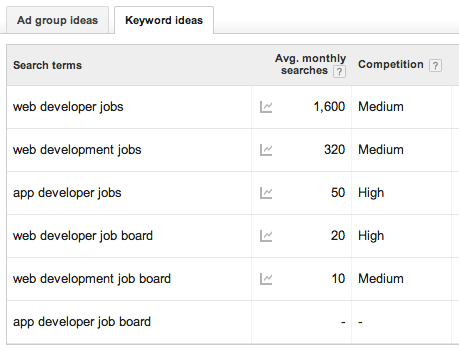
Armed with this knowledge, we were able to craft our website’s copy with a more targeted vocabulary for what people are searching for.
When trying to determine your audience’s vocabulary, try to find out:
- What do specific words mean?
- How do they phrase certain concepts?
- What rings a bell with them?
- What words do they respond most to?
Another useful tool for exploring your audience’s vocabulary is the free report from Followerwonk, which generates a word cloud of terms that your audience uses to describe themselves within their Twitter profiles (amongst other things). If you don’t yet have a Twitter following, you can just as easily enter the Twitter handle of your competitor to find out how their followers are using keywords within their profiles. For example, a competitor of my app Harpoon is Freshbooks. By analyzing the followers of Freshbooks, I can see the following word clouds:
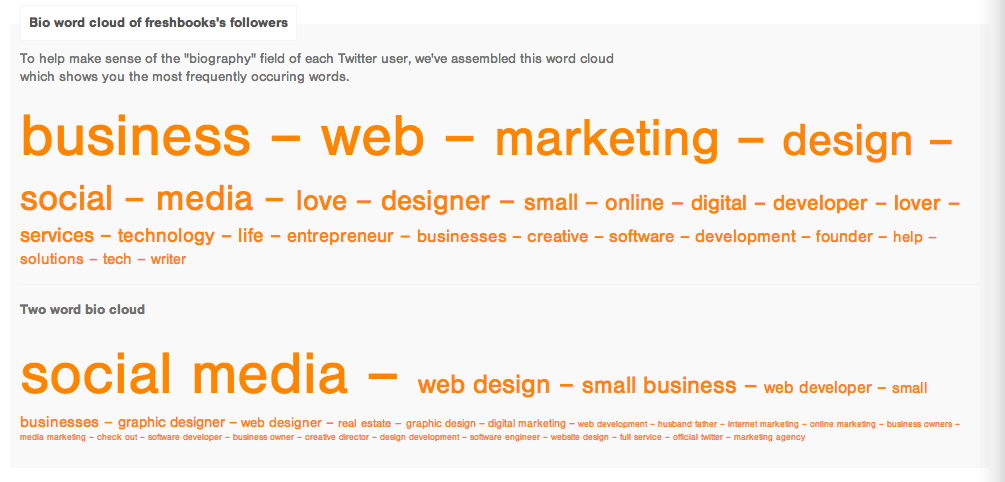
By taking a brief look at this analytic, I see that people who use online invoicing and time tracking–or at least those who follow the Twitter account of companies that provide this service–have a heavier bend towards marketing and design over development. It’s a slight edge, but the edge is there. I also see that they tend to refer to themselves more as a “designer” than a “creative”.
Understanding the Habits of Your Audience
Where does your audience hang out? What social networks do they use? What do they read? To be frank, there is no better substitute than to have conversations with multiple members of your audience. Call them up, and get them on Skype. Ask them what websites they like to read and what social networks they like to use.
Toastmasters International, a nonprofit educational organization that teaches public speaking and leadership skills, suggests that, if possible, the speaker greet people at the door and ask questions.
Getting to know your audience is no different. Sure, there isn’t a physical door to hang out in front of, but you can get out to conferences, you can attend meet-ups in your area, and you can reach out to people via social media and invite them to a brief coffee meeting.
Google Analytics can also help you out here, but showing you what social networks are referring the most traffic to your site. For example, for this blog, I’ve noticed that a significant amount of traffic is coming first from Twitter, but coming in at a close second is Reddit:
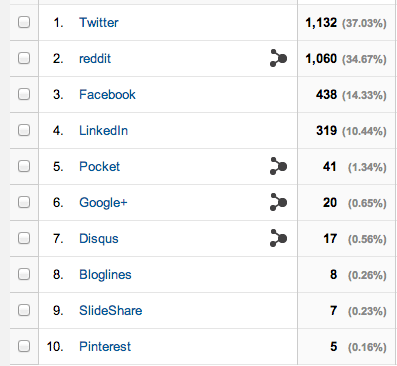
A few short months before this screenshot was taken, I had never even considered Reddit as a marketing channel. Thankfully, with analytics, I was able to quickly discover that Reddit was a very popular social network amongst my target audience.
Besides knowing what social networks your audience uses, it is also helpful to discover their interests outside of the industry that you are serving. This used to be a very difficult thing to do, but now that everybody’s interests are plastered all over social media, as well as the sites that they frequent, the data is there if someone is aggregating it. Fortunately, Google Analytics makes the data pretty easily available by enabling their demographics feature with a small modification to your Google Analytics tracking code (details are in Google Analytics when you try to click on “Demographics”).
For my blog, I was interested in what my audience was generally interested in, so running a report on the demographics gave me the following statistics:
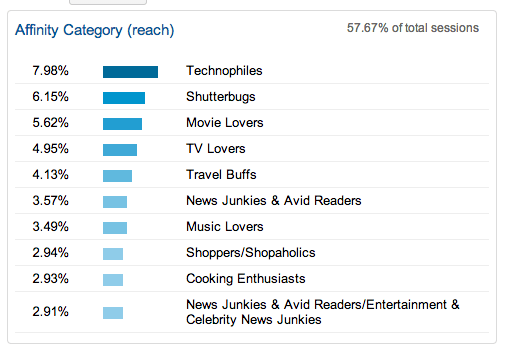
You’ll notice that this only represents 57.67% of total sessions, and that is because Google intentionally masks some data where they deem it would be too easy to narrow down the source to an identifiable individual, so certain thresholds must be met. Nevertheless, of the sampling group, the second-highest affinity category is “Shutterbugs”. Armed with this data I now know that a high-quality image for each blog post is going to be appreciated by the group.
Know What Competitors They Are Buying From
Most private companies won’t make their sales figures public knowledge, so it can be difficult to discern exactly how well a particular competitor is doing. However, as we’ve been covering here, social signals are abundant and using a tool such as Topsy Analytics (update: Topsy is no longer in operation), you can at least see which of your competitor’s brands are engaging your target audience the most via @replies on Twitter.
Three of Harpoon’s nearest competitors are Freshbooks, Harvest, and FreeAgent. By plugging those three Twitter handles into Topsy, I can see how many social mentions occur for those brands:
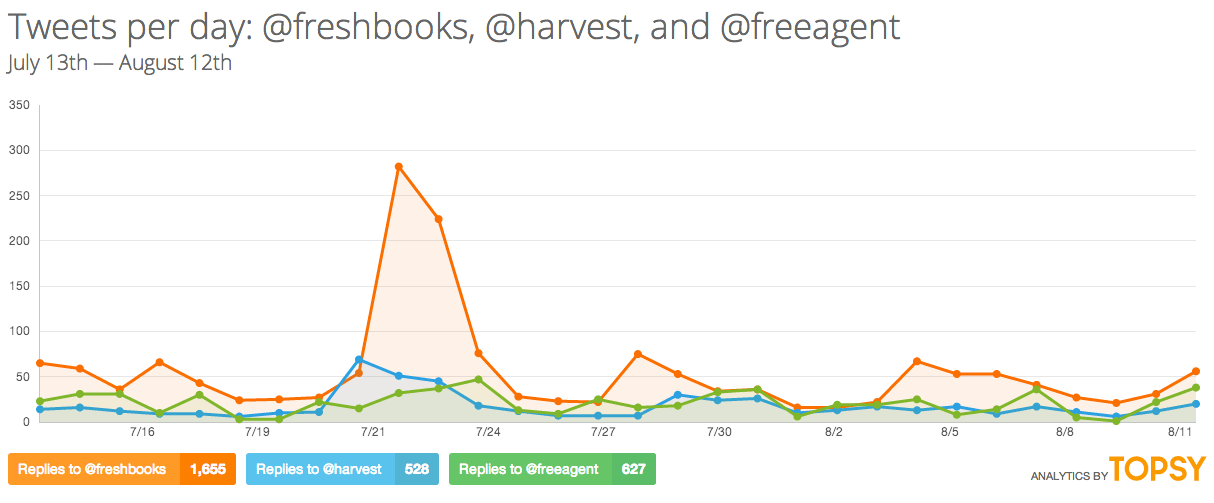
For the most part, Harvest and FreeAgent are on similar trajectories, and Freshbooks has a slight edge with somewhat of a bump around 7/22.
Of course, now I’m curious, what happened around 7/22 at Freshbooks that caused such a ruckus? It turns out that this famously bootstrapped company that started from the founder Mike McDerment’s parent’s basement has now accepted funding. Now this has all sorts of implications for my business that are outside of the scope of this article, but one thing to take note of is that this news matters to my target audience:
- Do they see this as a good thing?
- Do they see this as a negative thing?
- Does it secure their faith in their company?
- Will it cause some to jump ship?
- Is this an opportunity to reach out to some new users?
These questions can be explored when you are aware of who your audience is currently buying from, and what social signals are out there to digest and act upon.
In addition to social mentions, you can also check out which sites are linking to your various competitors by plugging their domain into Ahrefs Site Explorer (Free). This tool gives you insight into not only the level of buzz being attributed to the competition but also the sources of that buzz, which can then be repurposed to reverse-engineer your competition’s marketing strategies (but more on that in a later blog post).
Tools for Knowing Your Audience
To find out when your audience is online (or at least using Twitter), plug your Twitter credentials into Tweriod (update: Tweriod is no longer in business). You can then use this information to buffer your tweets at those times using Buffer or Hootsuite.
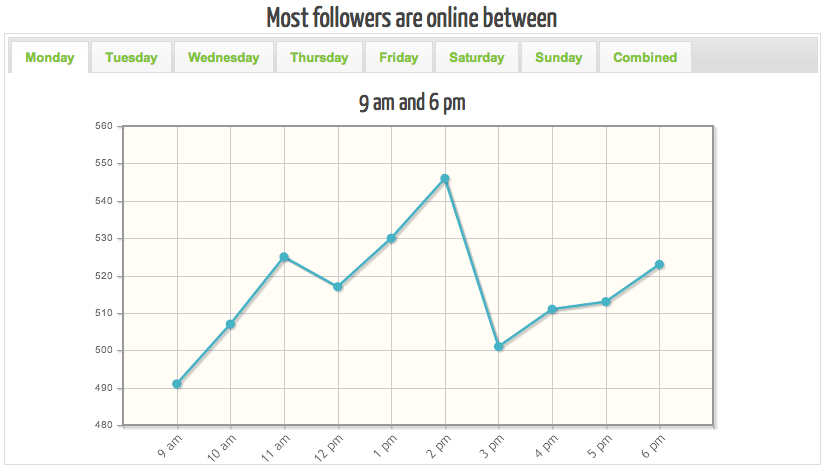
You can follow key influencers within your target industry to see what they are tweeting about using BuzzSumo or Klout (update: Klout is no longer in operation).
BuzzSumo will not only give you top influencers for a particular keyword combination but will also analyze their tweets for you with the click of a button.
I have seen a great audience influx from key influencers by:
- Making a list of key influencers
- Creating a List on Twitter of only their accounts
- Checking that list’s feed daily for chances to engage in meaningful conversation.
- Leave comments on these folk’s blogs.
- Get ready for them to start mentioning and tweeting about the interesting stuff you are doing!
Another great resource for getting to know your target audience is to spend an hour in the bookstore, perusing the magazines and books that are popular amongst your audience. What types of articles are being written? What types of businesses are advertising within these magazines? Magazine ads aren’t cheap, so if some advertisers are consistently purchasing space within a magazine, something is working for them. Learn from this and get to know what makes the audience tick, and even better, to buy!
If you don’t have the time to make it out to the bookstore, check out Amazon.com to see the bestsellers within a particular category. Read the comments, and see what people are thinking, what they like, and what they don’t like about products catered to their community.
Recommended Reading
Finally, to close out the article, I’d like to leave you with three sources for research-driven reports that give insight into general and specific trends in technology, social media trends, and industry predictions.
- Comscore Insights – Recent stories include predictions for the future of Snapchat’s use amongst adults and smartphone market share.
- eMarketer – Recent stories include a trend moving away from Twitter and into Facebook, and mobile search trends.
- Pew Research Internet Project – Recent stories include an assessment of the Web at age 25, and older adults’ use of technology.
Bookmark these sources for the occasional check-in to see if there are any new trends that you need to be aware of. Social media is a fast-changing landscape, and what is popular today won’t stay that way for long without some serious competition from new startups.
Concluding Remarks
While I have provided a lot of resources above, these are simply auxiliary tools to simply having an honest, human conversation with your audience to get to know them better. Don’t be afraid to send out emails inviting them to engage with you. That is where you will find the best benefit and gain the most knowledge if you go into it with an open attitude and goal to understand them better.